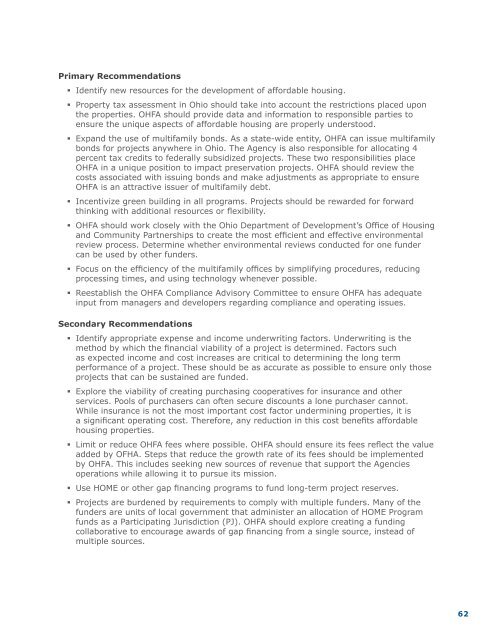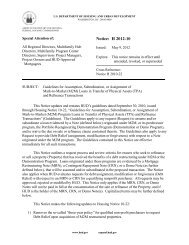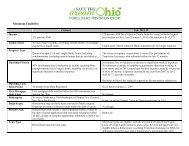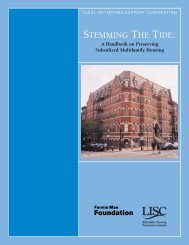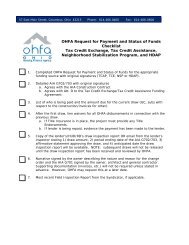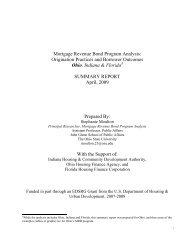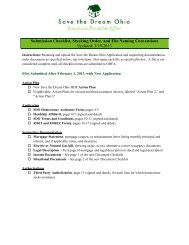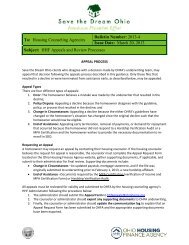Primary Recommendations• Identify new resources for the development of affordable housing.• Property tax assessment in <strong>Ohio</strong> should take into account the restrictions placed uponthe properties. <strong>OHFA</strong> should provide data and information to responsible parties toensure the unique aspects of affordable housing are properly understood.• Expand the use of multifamily bonds. As a state-wide entity, <strong>OHFA</strong> can issue multifamilybonds for projects anywhere in <strong>Ohio</strong>. The <strong>Agency</strong> is also responsible for allocating 4percent tax credits to federally subsidized projects. These two responsibilities place<strong>OHFA</strong> in a unique position to impact preservation projects. <strong>OHFA</strong> should review thecosts associated with issuing bonds and make adjustments as appropriate to ensure<strong>OHFA</strong> is an attractive issuer of multifamily debt.• Incentivize green building in all programs. Projects should be rewarded for forwardthinking with additional resources or flexibility.• <strong>OHFA</strong> should work closely with the <strong>Ohio</strong> Department of Development’s Office of <strong>Housing</strong>and Community Partnerships to create the most efficient and effective environmentalreview process. Determine whether environmental reviews conducted for one fundercan be used by other funders.• Focus on the efficiency of the multifamily offices by simplifying procedures, reducingprocessing times, and using technology whenever possible.• Reestablish the <strong>OHFA</strong> Compliance Advisory Committee to ensure <strong>OHFA</strong> has adequateinput from managers and developers regarding compliance and operating issues.Secondary Recommendations• Identify appropriate expense and income underwriting factors. Underwriting is themethod by which the financial viability of a project is determined. Factors suchas expected income and cost increases are critical to determining the long termperformance of a project. These should be as accurate as possible to ensure only thoseprojects that can be sustained are funded.• Explore the viability of creating purchasing cooperatives for insurance and otherservices. Pools of purchasers can often secure discounts a lone purchaser cannot.While insurance is not the most important cost factor undermining properties, it isa significant operating cost. Therefore, any reduction in this cost benefits affordablehousing properties.• Limit or reduce <strong>OHFA</strong> fees where possible. <strong>OHFA</strong> should ensure its fees reflect the valueadded by OFHA. Steps that reduce the growth rate of its fees should be implementedby <strong>OHFA</strong>. This includes seeking new sources of revenue that support the Agenciesoperations while allowing it to pursue its mission.• Use HOME or other gap financing programs to fund long-term project reserves.• Projects are burdened by requirements to comply with multiple funders. Many of thefunders are units of local government that administer an allocation of HOME Programfunds as a Participating Jurisdiction (PJ). <strong>OHFA</strong> should explore creating a fundingcollaborative to encourage awards of gap financing from a single source, instead ofmultiple sources.62
Workgroup #2:Affordable <strong>Housing</strong> PreservationWorkgroup MembersChair: Paul Henley, 5/3 CDCMembers: Debbie Barry, Millenia Management; Scott Hunley, HUD; Hal Keller, OCCH;Michelle Norris, National Church Residences; Jay Scott, <strong>Ohio</strong> <strong>Housing</strong> Council; Steve Smith,Model Group; Spencer Wells, COHHIO; Andrew Whapham, LW Associates.<strong>OHFA</strong> Staff: Sylvia Ray and Brian CarnahanMeeting HistoryTeleconference 8/7/08; meeting 8/12/08; meeting 9/12/08; teleconference 9/18/08;meeting 11/4/08<strong>Housing</strong> Need<strong>Ohio</strong> has a large and aging portfolio of subsidized housing properties across the state. Thishousing was developed using the Department of <strong>Housing</strong> and Urban Development (HUD)and Rural Development resources, including project-based rental subsidies. An additionalportfolio, largely developed using tax credits and other federal resources such as the HOMEProgram, is aging. These existing affordable rental properties are meeting many criticalhousing needs, including serving low and very low-income households, the elderly, andthose with special needs. Many of these apartment communities were developed whenstandards and market expectations were much different. Therefore, many units lack theamenities, such as central air conditioning and multiple bath rooms, many of us now takefor granted. Stagnant population growth and high construction costs for infrastructure andnew rental units are other factors to consider in allocating resources between building newand preserving existing affordable housing.Met <strong>Housing</strong> NeedsAffordable housing communities are currently being preserved using a number of programs.The tax credit program is an important funding source for preserving communities. Over thelast decade, preservation has been addressed with set-asides and special provisions in theQualified Allocation <strong>Plan</strong> (QAP). In 2008, 6 preservation projects, composed of 500 units,received a reservation of tax credits. Since 2001, 80 affordable housing projects have beenpreserved using tax credits. This has resulted in stable housing for the existing residents,opportunities for new residents, the retention of millions of dollars of rental assistance andprotection of the investment made with federal, state, and private resources. Preservationprojects funded with tax credits have also been financed with federal HOME funds and <strong>Ohio</strong><strong>Housing</strong> Trust Fund dollars.Many of the preservation projects financed with tax credits and gap financing from <strong>OHFA</strong>,have also been assisted by HUD’s “mark-to-market” programs, or USDA Rural Development.<strong>Ohio</strong> has been a leader in recognizing the need to preserve affordable rental housing.Various collaborative projects such as COHHIO led <strong>Ohio</strong> Preservation Advisory Group,indicate significant interest in preserving affordable housing. Preservation can be more costeffective and energy efficient than building new and is an important tool in creating newcommunity assets.63
- Page 3 and 4:
OHFA Annual PlanThe Ohio Housing Fi
- Page 5:
Mission StatementsThe OHFA Annual P
- Page 8 and 9:
The State’s Housing NeedsAffordab
- Page 10 and 11:
Subject Matter Expert (SME) Workgro
- Page 12 and 13: 3. Financial LiteracyOHFA and other
- Page 14 and 15: Affordable Housing Preservation & D
- Page 16 and 17: federal subsidies. To achieve this
- Page 18 and 19: Accessible HousingBackground DataOh
- Page 20 and 21: 3) Create dedicated funding streams
- Page 22 and 23: • Recommend that Ohio support the
- Page 24 and 25: Rural and Appalachian RegionsBackgr
- Page 26 and 27: 6. Annual Set-Asides and Incentives
- Page 28 and 29: • Several cities in Ohio current
- Page 30 and 31: OHFA should provide funding, traini
- Page 32 and 33: Permanent Supportive Housing Produc
- Page 34 and 35: 3. The State should assist local Co
- Page 45 and 46: PrioritizationThe challenge of prio
- Page 47 and 48: Agency RecommendationsThe Annual Pl
- Page 49 and 50: APPENDIXWorkgroup 1: Affordable Hom
- Page 51 and 52: Executive SummaryHousing Need Descr
- Page 53 and 54: efficiency and resource conservatio
- Page 55 and 56: 554. Home Buyer Education in OHFA F
- Page 57 and 58: Estimated Units in Need of Some For
- Page 59 and 60: Ohio County Foreclosure Filings (19
- Page 61: Operating Costs - Met and Unmet Nee
- Page 65 and 66: Secondary Recommendations• Explor
- Page 67 and 68: Executive SummaryOhio’s supply of
- Page 69 and 70: Met Housing Needs (“Resource Inve
- Page 71 and 72: Ohio Deptof MentalRetardation andDe
- Page 73 and 74: Unmet Housing NeedsData OverviewThe
- Page 75 and 76: ody, and will be built within the C
- Page 77 and 78: • OHFA will continue to maintain
- Page 79 and 80: Best Practices, Policies and Progra
- Page 81 and 82: addition, 60,111 one-person househo
- Page 83 and 84: Across Ohio, people with very low i
- Page 85 and 86: • Responsible for Rent - The pers
- Page 87 and 88: Seattle, St. Louis, and Washington,
- Page 89 and 90: Primary Recommendations• Create a
- Page 91 and 92: Unmet Housing Needs:• Due to the
- Page 93 and 94: • The cost of construction often
- Page 95 and 96: Recommendations for Annual Plan Adv
- Page 97 and 98: capacity to quantify vacant propert
- Page 99 and 100: distributed on or about January 15,
- Page 101 and 102: Action is needed at the State level
- Page 103 and 104: a “user-friendly” data system,
- Page 105 and 106: 5) Incentivize the formation of bro
- Page 107 and 108: Workgroup #8:Permanent Supportive H
- Page 109 and 110: 3. Assist local Continuums of Care
- Page 111 and 112: Program and Resource InventoryNonpr
- Page 113 and 114:
Table 2PopulationsPersons whoexperi
- Page 115 and 116:
Examples: A national model for succ
- Page 117 and 118:
oles, so they create a contract bet
- Page 119 and 120:
Workgroup #8:Appendix ANameProgramD
- Page 121 and 122:
or remedyingneglect, abuse,or the e
- Page 123 and 124:
ased healthcare, and earlyintervent
- Page 125 and 126:
“Bob” of Stark County, OhioPubl


